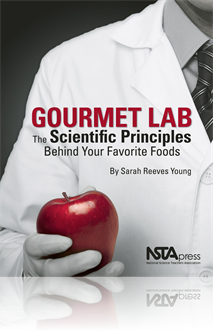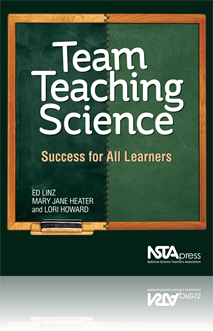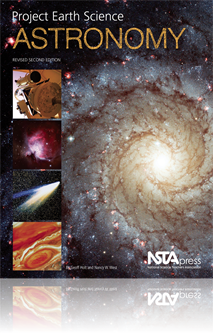All Book Chapters
Book Chapter
Berries and Bacteria: Measuring How Acids and Heat Impact Bacteria in Jam
Have you ever had a ripe apple, a juicy strawberry, or a succulent peach? Did the juices flow into your mouth with each bite as you devoured it? On the other hand, have you ever had a piece of fruit that was less than perfect? This experiment uses ...
Book Chapter
American Mozzarella: Calculating Rates of Change for Rennet in Cheese Making
Legend has it that mozzarella was first made when cheese curds accidentally fell into a pail of hot water in a cheese factory near Naples, Italy...and presto—a new cheese was made, and pizza shops starting popping up all over. This experiment wil...
Book Chapter
You have recently found yourself assigned to team teach science. You may be a science teacher with no experience working with a class containing several students with special needs, or you may be a special education teacher who has never taught scien...
Book Chapter
Team teachers need to recognize the importance of establishing positive relationships with school professionals, principals, and parents. These relationships can be accomplished by focusing on establishing communication strategies and working to reso...
Book Chapter
This chapter sums up what the authors hope you have learned in previous chapters of Team Teaching Science: Success for All Learners....
Book Chapter
Teaching Science: A Historical Perspective
It is the authors’ contention that a team of two teachers, one a science teacher with solid content background and the other a special-education-trained teacher, can create a particularly effective synergy to deliver science instruction to what is ...
Book Chapter
Teaching Science: The Instruction
Teaching science has unique challenges and opportunities for the co-teaching team. Science can be taught with a hands-on approach that encourages students to explore concepts and ideas through interaction. Science lessons can also use simulations or ...
Book Chapter
In this chapter, the importance of communication on a variety of topics is discussed. Each co-teaching team is unique and will have differing preferences for how to establish their working relationship. A good co-teaching relationship is an exciting ...
Book Chapter
Team Teaching: Science in the Elementary Classroom
Many of the challenges of team teaching—such as communication, content knowledge, and joint instruction—are issues that all co-teachers must address; however, there are unique characteristics to the elementary classroom that must be navigated by ...
Book Chapter
Team Teaching: Science in the Middle School Classroom
Co-teachers in science at the middle school level must address co-teaching issues as well as the unique challenges of instructing middle school learners. Middle school is just that—in the middle, between elementary school and high school. Middle sc...
Book Chapter
A Team-Teaching Game Plan for One School Year
This chapter helps to outline what all co-teaching teams should be doing during each phase of a typical school year. Because the two individuals involved in co-teaching are operating in a situation in which there must be teamwork, the authors recomme...
Book Chapter
Teaching Science to Students With Special Needs in Advance Classes
Most advanced science classes are not team taught. Although there may be several students with special needs in honors, gifted and talented, International Baccalaureate (IB), or Advanced Placement (AP) science classes, classroom instruction is typica...
Book Chapter
Science and Art: Dueling Disciplines or Dynamic Duo?
A mixer activity (supplemented by “scientific” art, music, and optional demonstrations) is used to catalyze a conversation on the similarities and differences between the sciences and the arts. ...
Book Chapter
5 E(z) Yet pHenomenal Steps to Demystifying Magic Color-Changing Markers
In this chapter you will explore, the chemical principles that explain the “science behind the magic” of color changing markers are explored in a series of teacher-guided but learner-designed hands-on explorations....
Book Chapter
5 E(z) Steps Back Into “Deep” Time: Visualizing the Geobiological Timescale
In this chapter, you will explore a sequence of fun, participatory activities juxtapose everyday popular culture and human time perspectives with the geobiological timescale of Earth’s history of millions and billions of years. The overall timesca...
Book Chapter
5 E(z) Steps to Earth-Moon Scaling: Measurements and Magnitudes Matter
Learners are surprised to learn that most textbook illustrations incorrectly represent the relative sizes and/or distance between Earth and its single moon. Although these and other visual representations of our solar system “lie” or grossly misr...
Book Chapter
Acronyms and Acrostics Articulate Attributes of Science (and Science Teaching)
Learners’ ideas about the nature of science, school science, and science teaching are elicited by their creation of acronyms or acrostics that define key characteristics of science and teaching. An Extension activity provides discussion questions f...
Book Chapter
Tackling the Terrible Tyranny of Terminology: Divide and Conquer
Big, hard words in science are invariably made up of small, easy Greek- and Latin-based prefixes, suffixes, and root words that students can systematically learn, continually use, and creatively recombine. An unusually long science word; a simple (...
Book Chapter
Inquiring Into Reading as Meaning-Making: Do Spelling and Punctuation Really Matter?
Learners are asked to read a passage full of misspelled words. Many readers are able to discern the meaning despite the numerous intentionally embedded errors. In a second exercise, learners experience how the meaning of a passage can be dramatically...
Book Chapter
Ambiguous Text: Meaning-Making in Reading and Science
Learners are asked to read one or more passages of ambiguous, discrepant text where they understand the individual words (or “trees”) but are hard-pressed to connect the words with an overall context (or “forest”) to extract and construct mea...
Book Chapter
Glue Mini-Monster: Wanted Dead or Alive?
A drop of clear, colorless, viscous liquid (i.e., a specific brand of modeling glue) assumes the role of an unknown macroscopic, single-celled organism in this demonstration. When placed in a petri dish of water, it is observed to move and interact ...
Book Chapter
Water “Stick-to-It-Ness”: A Penny for Your Thoughts
Water (in contrast to other clear, household liquids) assumes and maintains a very distinct semispherical shape when placed on a piece of waxed paper. For related reasons, a discrepantly large number of drops of water can be placed on top of a penny...
Book Chapter
Burdock and Velcro: Mother Nature Knows Best
In this chapter’s activity, Velcro is explored as an example of a human-engineered invention that was a “copycat” inspired by a naturally evolved, “bio-engineered” seed distribution innovation....
Book Chapter
Book Chapter
Greenhouses are made almost completely of glass for two reasons. First, glass allows the maximum amount of sunlight into the building. Plants need the sunlight for photosynthesis. Second, glass prevents heat produced in the greenhouse from escaping....
Book Chapter
Ballpark Pretzels: Using Microscopes to Observe Yeast Fermentation of Sugar
The experiment in this free chapter provides a hands-on lab experience for students to being their investigation into yeast and the fermentation of sugars. The experiment allows students to view the yeast under the microscope, gaining skills in using...
Book Chapter
Osmosis and "Naked" Eggs: The Environment Matters
Osmosis is the diffusion of water through a selectively permeable membrane. Given their size and availability, the hard exterior shell of eggs provide a convenient macro-scale model of the system-level phenomenon of osmosis. Once the shell of a fres...
Book Chapter
Edible Plate Tectonics: Plates Move and Interact
Plate tectonics is geology’s central theory and one of the most important in science. It provides explanations for many of Earth’s major geological processes and physical features. This Activity uses an unusual physical model to introduce some of...
Book Chapter
Convection: Transfer of Heat From Earth’s Interior
In this activity, students conduct experimental trials involving a drop of food coloring moved by convection in a pan of water to observe convection cells. Students record their observations on this model and relate what is observed in the pan to wha...
Book Chapter
A Voyage Through Time: Pangaea Breakup and Continent/Plate Movement
In this activity, students will follow the movement of continents over the past 200 million years, beginning with the breakup of Pangaea. Students analyze the consequences of plate tectonics on continents by modeling the breakup of Pangaea via a flip...
Book Chapter
Magma and Volcanoes: Model of a Volcano
Students, in this activity, model a volcanic eruption by melting crayons inside a plaster of paris model. They use a hot water bath to melt the wax, which rises through a tube they made with string in the plaster of paris...
Book Chapter
Shake It Up: Earthquakes and Damage to Buildings
Nearly all locations on Earth experience occasional earthquakes, although most of them are not large enough to cause significant damage. In this activity, students will use sugar cubes to investigate and compare the effects of an earthquake on differ...
Book Chapter
Study Your Sandwich: Sedimentary Rock Layers, Structures, and Relative Ages
In this activity, students make a triple-decker, soy butter with raisins and jelly sandwich to model sedimentary rock formations. They take core samples with a straw, fold the sandwich into synclines and anticlines, and cut it to simulate faulting. F...
Book Chapter
GeoPatterns: Global Earthquake Distribution
Do earthquakes occur randomly, or are there patterns to their distribution? Does where earthquakes occur shed light on why they occur? What causes earthquakes? What determines where an earthquake will occur? In this Activity, students will look for p...
Book Chapter
The Reading on Plate Tectonics elaborates on the concepts presented in the Activities section of Project Earth Science: Geology, Revised 2nd Edition. This Reading was written especially for this volume with the teacher in mind. The outer part of ...
Book Chapter
Volcanoes and Plates: Volcanic Activity and Plate Boundaries
In this activity, students compare locations of volcanoes to the types of rocks erupted and tie this in to the motions of lithospheric plates. They will map rocks by their main chemical components. Students then discern plate boundaries from their ma...
Book Chapter
The Reading on Volcanoes elaborates on the concepts presented in the Activities section of Project Earth Science: Geology, Revised 2nd Edition. This Reading was written especially for this volume with the teacher in mind. Volcanic activity occu...
Book Chapter
Volcanoes and Hot Spots: Formation of Hawaiian Islands
Students, in this activity, relate plate movement to trails of volcanoes by modeling a hot spot with hot colored water rising under a floating Styrofoam plate. Questions guide students to connecting their model to Hawaiian volcanoes and the Emperor S...
Book Chapter
The Reading on Earthquakes elaborates on the concepts presented in the Activities section of Project Earth Science: Geology, Revised 2nd Edition. This Reading was written especially for this volume with the teacher in mind. Most earthquakes occ...
Book Chapter
All Cracked Up: Model of Earth’s Layers
In this Activity, students will learn more about the structure or layering of Earth. Students analyze a hard-boiled egg as a model for Earth’s interior structure. They then scrutinize and evaluate other objects as models for Earth. ...







